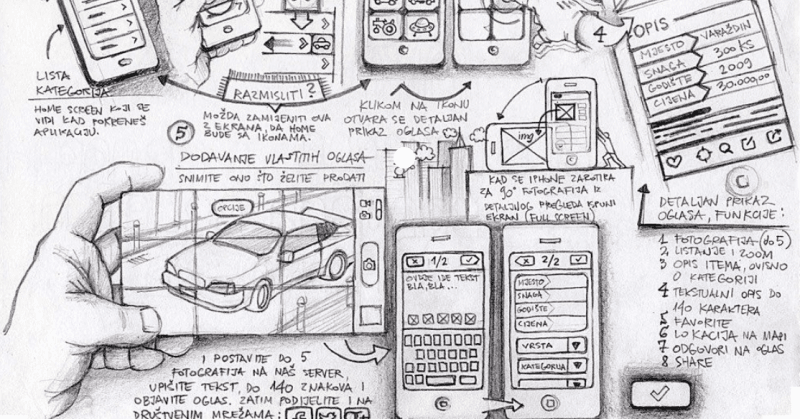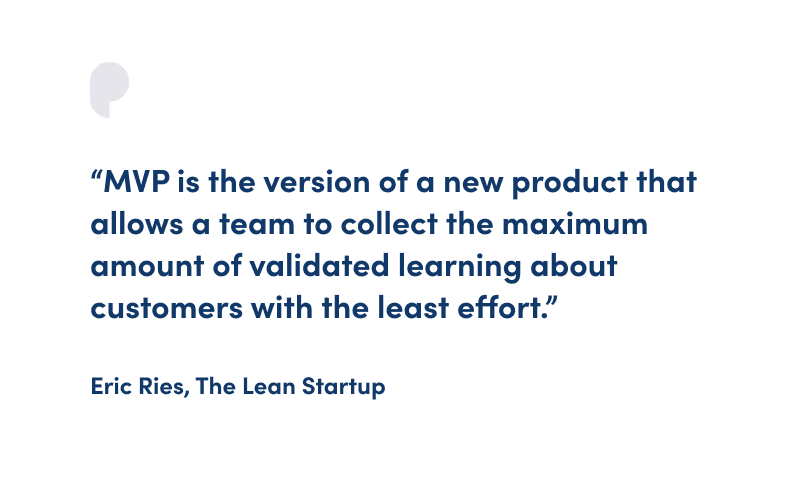Updated: May 6, 2025- 10 min read
Prototypes and Minimum Viable Products (MVP) are a critical part of Product Development. Sure, you could dive right in, spend months developing an expensive product with all the bells and whistles…only to find that at launch, nobody wants it. Or you’ve built it completely wrong. Or you could have built something way better if you’d pivoted halfway through.
Not testing your ideas is a great way to fail (and not in a helpful way).
That’s where MVPs and prototypes come in! They help you find your Product-Market Fit, get stakeholder and user feedback, and start building buzz around your upcoming launch. They’re also a great communication tool between you and your designers/tech teams, and they help you understand what it is you’re building.
But what do ‘prototype’ and ‘MVP’ actually mean?
Well, a prototype is a lightweight early-version of your product. And an MVP is also a lightweight early-version of your product.
Done!
…if only it were that simple. While in theory MVPs and prototypes seem like the same thing, and both are part of agile product development, there are a few key differences.
Here we’re going to take you through everything you need to know about prototypes and MVPs. We’ll look at:
What a prototype is for, and the forms it can take.
What an MVP is.
Examples of MVPs that became huge, successful products.
The subtle differences between a prototype and an MVP.
Tips on how to build your own.
What is a Prototype?
A prototype is what happens when you give form to your product idea. It’s something tangible, not just in your head.
Prototypes can vary in size and how much time and effort you put into them. They might be a simple sketch on paper, or something more functional and interactive.
The main benefit of a prototype is that it helps you to communicate with your design and engineering teams. You need to show them what to build! Think of it as the packaging of an empty box. It shows you what’s inside and what it looks like, but there’s currently nothing going on underneath.
Depending on your skill level, you can make your prototype as complicated or as simple as you like.
Different Types of Prototypes

Paper sketches: This is the lowest level of prototype. If you can wield a pencil, you can manage! Draw out a basic idea of what your user interface will look like. If you want to make something visually appealing to communicate to investors/stakeholders, work with a designer to create something that fits your vision.
Digital prototypes: You can also create a working mock-up of your envisioned product, and there are many tools to help you do so.
The rule of thumb when picking prototyping tools is their complexity: you might not need all the features in the world to make your project scream SUCCESS.
For a web-based app, if you’re just starting out and don’t have a big budget/powerful computer, we can recommend Proto.io. In terms of standalone apps, InVision, Figma, Balsamiq, Axure RP, Sketch (for Mac only) and Adobe XD are good options.
Read about more types of prototypes.
Prototype Inspiration
Need some ideas? Check out these awesome prototype examples!
What is an MVP?
The meaning of MVP is Minimum Viable Product. It’s the bare minimum version of your product that still solves the problem for your customers. Eric Ries describes it perfectly in The Lean Startup.

Think of it like this: if someone needed transportation between Point A and Point B, and they’re not sure how best to get there, the first thing you give them wouldn’t be a Tesla! You might start with a skateboard, or a scooter. You get the feedback that they want something motorized, so you get them a motorbike. It does the job, but now they want something waterproof, with some kind of entertainment system. So eventually you give them a car with built-in radio.
Without testing, and understand what works and what doesn’t, you might have given them a skateboard with a Nintendo Wii strapped to the front instead.
An MVP fits naturally into a product operating model as a key tactic within the broader product discovery and delivery process. It supports fast learning, reduces waste, and helps teams validate assumptions before scaling solutions—all of which are central to modern, outcome-focused product organizations.
Examples of MVPs that became products

1. Groupon: A WordPress site and PDFs
While Groupon didn’t exactly invent the voucher (extreme couponing has been a hobby for generations!), they helped it become a staple of our social lives and shopping habits.
It started out as a bare-bones operation. At launch, they had a basic WordPress site and would email normal PDFs as vouchers to subscribers. Once they proved that there was a demand for an online voucher marketplace, they invested in building a more elaborate backend.
Despite suffering a decline in customers thanks to the pandemic, they remain one of the most popular coupon websites in the internet.
2. Airbnb: From 3 guests to 400 million
The Airbnb we know and love today started out as AirBed&Breakfast, a very basic website which provided accommodation to people who came to San Francisco for a design conference.
The problem that founders Brian Chesky and Joe Gebbia were trying to solve was that they couldn’t afford the rent on their loft apartment. Short-term rentals were arduous and often involved big bills to middlemen.
After testing their idea on 3 paying guests during the conference, Airbnb grew organically to the powerhouse we know today. It even involved Brian Chesky staying in early listings to give the platform some traction.
Had they not tested, they could have build an extravagant system, with all the cool features Airbnb has now, only to find that people didn’t want to stay in other people’s homes. Luckily for them, they were onto something…
3. Dropbox: The product that didn’t exist
Dropbox is a fantastic example of Product-Led Growth done well.
But in the beginning, they didn’t have a product at all!
Instead of building a full product, they came up with a working MVP, created a video explainer, and essentially pretended that it existed.
This helped them to test their idea. Had they built the complicated backend, only to find that nobody wanted their product, they would have lost countless hours of work.
From their introductory video, they received over 70k email addresses from people wanting Dropbox ASAP. They’d proved their idea had legs without spending a lot of money getting it to walk.
4. Spotify: Do one thing and do it well
When Spotify first launched its MVP to the world, it aimed to do one thing: stream music. They built an MVP which only streamed songs, without all of the extra features (playlists, podcasts, video, mobile app etc), and launched a closed beta to test their idea. Everyone loved it, and the freemium model was popular with users.
Knowing that their MVP was a hit, and their business model was proven, they rolled out a full launch and have experienced year on year growth ever since.
As of 2023, Spotify had 195 million premium subscribers.
What is The Difference Between Prototype and MVP?

Breaking it down simply, the main differences are:
Scope
Commitment
Audience
The scope of a prototype and an MVP vary greatly. A prototype is something that you can put very little time and effort into. The idea is to come up with a variety of prototypes, and be able to change, adapt, and throw away ideas quickly.
With an MVP, you’ve picked an idea and you’re rolling with it, which means putting in a little more effort. You’re likely to use more resources and have more people involved.
Watch: How to Build and Launch your MVP by Microsoft PM
Because of the difference in scope, your commitment level is also different. Once you’ve invested time and resources into an MVP, you’re less likely to completely scrap it. While the whole concept of MVP is based on the ability to be cost-effective and make rapid changes, it’ll still be painful to get rid of it entirely and start from scratch.
With a prototype, it can be as easy as crumpling up the paper and starting again! Although more complex prototypes certainly take up more resources, you’re still less tied to them than you are to a fully realized MVP.
Your prototypes and your MVPs will also be intended for different audiences. Prototypes are mostly internal. Mainly intended for your teams, or others in your company. At most, you’ll give them to the press to create a bit of buzz, or use them for crowdfunding purposes. But they’re not intended for your target market en masse.
An MVP, as we’ve now seen, is intended to be launched to your target market in order to assess its reception. The P stands for Product, after all! An MVP is something that the public will be judging you on, and something which people may remember when the time comes to commit to V2.
Tips for Building Your Prototype or MVP

Now that you know the difference, you might be thinking about how to build a prototype or MVP. While the resources and data you’ll need are different for each, there are a few golden rules that you can apply, no matter what you’re building.
1. Stay customer-focused: So many of the world’s most successful companies credit their customer-focus as the secret to building winning products. The goal of your product is to provide value, so be sure to focus on who you’re building for.
2. Stay data-driven: You don’t have to be a data scientist to be a Product Manager, but don’t think that numbers shouldn’t matter to you. You might not have an extensive data set if you’re building your first ever product, so think about what data you want to collect from your prototype/MVP. It’ll help you later in development, and for future releases.
3. Kill your darlings: You might really love your prototype/MVP. But if no one else does…it’s time to rethink! The only thing waiting for you if you launch something nobody wants, is failure.
4. Just build the thing! You can agonize over perfecting your prototype before committing to an MVP. You can also spend months working and reworking your MVP before you feel ready to launch it. If you want to build products, eventually it’s time to let go and let people see them!
Learn more with Product School
Now you’re ready to build! For next steps, you might consider starting a side hustle. For a lower commitment option, check out this guide for Hackathons! If you're ready to start building like Product Managers do, don't miss Product School's Product Management Certification, where you'll get hands-on learning by building products and solving real-world problems.
Updated: May 6, 2025





